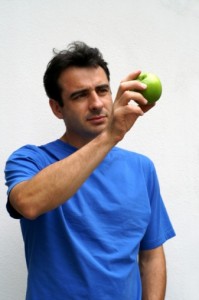Four Existential Questions (Part 2)
By Asher Crispe: May 4, 2012: Category Decoding the Tradition, Inspirations
What are the big questions in life?
 A cursory review of the four questions that stand as the highlight of the Passover seder does not seem to reflect more than an effort to retain a collective memory of a past historical event. Coupled with this, we can regard these questions as an exercise in pedagogy that focuses our attention upon the symbols of that memory and how they enrich Jewish specificity. Yet, contrary to this initial impression, what is ultimately masked here are the most universal questions that are fundamental to all human beings.
A cursory review of the four questions that stand as the highlight of the Passover seder does not seem to reflect more than an effort to retain a collective memory of a past historical event. Coupled with this, we can regard these questions as an exercise in pedagogy that focuses our attention upon the symbols of that memory and how they enrich Jewish specificity. Yet, contrary to this initial impression, what is ultimately masked here are the most universal questions that are fundamental to all human beings.
Question one: Double dipping
Of all of the associations with the matbilin or dipping that takes place during the seder, it is the notion of dipping into the charoset that is assigned the most importance. Charoset, is a paste made up of ground up apple, nuts and pears etc…all of which symbolize different qualities of the Jewish people as alluded to in various passages in Song of Songs. Of all the ingredients, the apple figures the most prominently according to tradition.
Regarding the apple, we find in Song of Songs 8:5 “I aroused you under the apple tree….” One of the great Torah commentators known as the Malbim (1809-1879) writes that the apple tree is a veiled reference to the Zoharic idea of an abstract origin of souls in the chakal tapukin kadishim—what might be literally rendered as the ‘Holy apple orchard’.
As a mystical notion, the apple orchard implies a kind of filing system in the Divine economy wherein different souls have a unique point of origin that is nonetheless part of a larger system. The network of trees constitutes one orchard, thus maintaining a arboreal commonality to all of them. All are planted in the King’s domain—an outgrowth of a single Divine reality which precedes and supersedes the world.
Concurrently, each tree acts like a general soul classification. We are a multitude of organizational levels which funnel us down from the specific tree to the specific branch to the proximate cluster of apples on the end of that branch. Their relative placement and arrangement, one to the next, functions as an engine of difference. Perhaps we could liken this to having a routing method that must note our country, state, city and street address in the process of differentiating ourselves. In short, our spiritual composition comprises sets and subsets whose generality or specificity give shape to a discernible self. As with one’s list of organizations that a person belongs to, one’s membership within these taxonomic structures cannot consolidate two individuals into one. No two souls follow the same forking paths on the tree. Each is a unique apple. Holiness implies this uniqueness. It denotes that which is set apart, the mark of distinction. Holiness signifies our non-arbitrariness.
Some take this comparison even further and relate the word tapuach (apple) to the phrase used in the creation of mankind in the the garden of Eden from Genesis 2:7 where the verse says: “…and He (God) blew [v’yipach] into his nostrils the breath of live….” In Kabbalah this is taken to be event of contracting our being or the ensoulment of a person.
Given that one who exhales externalizes what was previously inside of himself, the soul of a person compares to an actual part of the Creator. From our perspective, we may relate to our ultimate origin as being of one substance with the Divine and yet we paradoxically regard ourselves as ‘other’ to the Divine at the same time. Deep down our sense of self can be thought of as a quasi externalization of an interior dimension of Divinity. We are formed as a result of Divine self-expression. The soul is a manifestation of Divinity. Furthermore, each and every soul is an utterly singular manifestation. Each is irreplaceable.  Our root existence, while shared on more general levels, ends in a apple all its own, a non-transferable, non-exchangeable fruit of Creation.
Our root existence, while shared on more general levels, ends in a apple all its own, a non-transferable, non-exchangeable fruit of Creation.
Consequently, the question here is one of selection. Our selection is path dependent (which tree of the orchard, which branches with all their sub-divisions etc…). Can we learn to trace it all? Does a kind of wiretapping of the cosmic conversation exist? And if so, how far back can we go? The quest for origins eventually reaches back to a time immemorial, to a past which has no record in this world because it stems from a place prior to the soul’s descent.
In more philosophic and less theological terms: the soul, prior to its decent into a body, (a common them in Chassidic discourses) represents our pre-embodied, unsituated inner being or nucleic subjectivity. The body and the world are co-extensive phenomena such that both in-corporate a person and thereby transform the human subject into an object. Despite the charm of our embodiment which underwrites our sense of separation and autonomy, the root of the person remains a being which is continuous with all Being. To paraphrase: our private reality on some hidden level must be seen as congruent with ultimate reality (the breath of life from the Creator as the soul of humanity).
Being both unlike anyone else while simultaneously processing membership within several groupings as part of a tree in an orchard, we are confronted by a twofold question about our chosenness. As a hot button topic that is not well understood, the notion of Jewish chosenness—of being a part of the chosen people—actual sets up a model for everyone.
We can think of it as follows:
Why was I chosen? This question addresses the deep seated need to come to terms with one’s unique life mission. The unavoidable rite of passage requires us to ask: What is my calling? All of the big goals and guiding principles that ferry us through time awaken in our consciousness a sense of purpose are wrapped in this quandary.
Beyond being chosen for an assignment, we may come to feel that all that has befallen me—my entire life’s adventure with all of its ups and downs—may have been a tailor made script that was written from the outset with me cast as the actor. Why have the things that have happened to me happened to ME!?
Good and bad, why me God? Could I have been picked for each and every scene that I am in? That cold last week—why me? That winning lotto ticket: why me? That gift of music: why me? That chronic bad breath: why me?
I don’t recall signing up for any of these things? Personal choice slams into being personally chosen.
Then there is the collective level that must shout out: why us? Why have so many historical events happened to some group which I belong to? It could be one’s family: why were we pulled aside for extra airport screening? How come we didn’t get the lake view rooms at the hotel? Why are we so blessed to live in this house?
Maybe it is a question of tribe. Modern tribes include political affiliations, trade unions, sports teams, business consortiums, etc.. The tribal model of course exists in Judaism. As a collective, if we address our common goals, our common purpose, our common interests, common history, we are venturing beyond the personal into the domain of group dynamics and the question of why us? Why were we chosen?
If you’re concerned with why the Holocaust befell the Jewish people, or why there are so many Jewish Nobel prize winners or why was the Torah given to us to give to the world, you are entertaining questions of chosenness.
By extension, all peoples of the world must face this question. What does it mean to be an American? Or to be a teacher? To be female? Or to love baseball? In Kabbalah, we acquire many levels of personal and collect unicity.
The root for dipping in Hebrew [tet-beit-lamed] can be seen as a permutation of the root for self-nullification or rather self-transcendence [beit-tet-lamed]. This implies an immersion [dipping] in the transcendent origin of self or the place on high where the self is rooted in Divinity.
 Here we inquire beyond the world or before it, within it and after it again and again: why did You [God] choose to create me and for what was I created? Why am I here? Likewise, why did You [God] choose us and for what were we created? Why are we here? Clearly we’re looking for metaphysical responses.
Here we inquire beyond the world or before it, within it and after it again and again: why did You [God] choose to create me and for what was I created? Why am I here? Likewise, why did You [God] choose us and for what were we created? Why are we here? Clearly we’re looking for metaphysical responses.
This is the lead question (according to the version of Arizal) that cuts to the core of our existence.
The way in which we ask ourselves this question changes the confusion of the night and having the courage to ask it again and again speeds the revelation of our ability to transform our situation in life.
In part three we will address the matzah or unleavened bread.
http://www.interinclusion.org/inspirations/four-existential-questions-part-three/
http://www.interinclusion.org/inspirations/decoding/four-existential-questions-part-1/
Four Existential Questions (Part 2),






















;)
;)
;)
;)
;)
;)
;)
;)
;)
;)
